Free E-Mail
Bible Studies
Beginning the Journey (for new Christians). en Español
Old Testament
Abraham
Jacob
Moses
Joshua
Gideon
David, Life of
Elijah
Psalms
Solomon
Songs of Ascent (Ps 120-135)
Isaiah
Advent/Messianic Scriptures
Daniel
Rebuild & Renew: Post-Exilic Books
Gospels
Christmas Incarnation
(Mt, Lk)
Sermon on the Mount
(Mt 5-7)
Mark
Luke's
Gospel
John's Gospel
7 Last Words of Christ
Parables
Jesus and the Kingdom
Resurrection
Apostle Peter
Acts
The Early Church
(Acts 1-12)
Apostle Paul
(Acts 12-28)
Paul's Epistles
Christ Powered Life (Rom 5-8)
1 Corinthians
2 Corinthians
Galatians
Ephesians
Vision for Church
(Eph)
Philippians
Colossians,
Philemon
1
& 2 Thessalonians
1 & 2 Timothy,
Titus
General Epistles
Hebrews
James
1 Peter
2 Peter, Jude
1, 2, and 3 John
Revelation
Revelation
Conquering Lamb of Revelation
Topical
Glorious Kingdom, The
Grace
Great Prayers
Holy Spirit, Disciple's Guide
Humility
Lamb of God
Listening for God's Voice
Lord's Supper
Names of God
Names of Jesus
Christian Art
About Us
Podcasts
Contact Us
Dr. Wilson's Books
Donations
Watercolors
Sitemap
Chi Rho, Chrismon, Monogram of Christ, Labarum
Chi and Rho are the first two letters (ΧΡ) of "Christ" in Greek ΧΡΙΣΤΟΣ. (Christos). Sometimes it is called the Monogram of Christ or Chrismon or Labarum. While it was used very early by persecuted Christians in the catacombs, when Constantine I was struggling to become emperor, he used the symbol at the front of his armies and was victorious (see below).
 Gravestone for the boy Asellus. Catacomb picture of Peter and Paul with the Chi-Rho symbol between them. Marble catacomb inscription, Pio Cristiano: Vatican Museum |
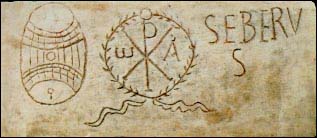 Chi-Rho symbol as part of a marble catacomb gravestone of Seberus, Pio Cristiano: Vatican Museum. Notice the Omega and Alpha symbols to the left and right of the Chi-Rho. |
The Chi-Rho is often shown with the Greek letters Alpha (A) and Omega (lower case ώ or upper case Ω), the first and last letters of the Greek alphabet. Jesus refers to himself: "I am the Alpha and the Omega, the First and the Last, the Beginning and the End." (Revelation 22:13).
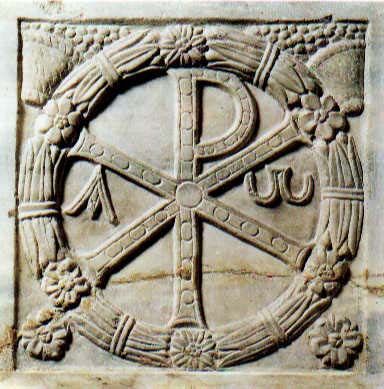 Monogram of Christ, Museo Pio Cristiano, Vatican, undated. Notice the Alpha and Omega symbols as part of the Chi-Rho monogram. |
The story goes that in In 312 AD, Constantine (ruled 306 - 337) was about to lead his army in a battle with his enemy Maxentius at the Milvian Bridge outside Rome. The winner would become emperor of the whole empire. Oiginally Constantine had been a pagan, but he was worried about the coming battle. He says he started to pray to the "Supreme God" for help.There was a sign in the sky "above the sun" and with it the words "conquer by this". That night in a dream he said he saw Jesus telling him to use the chi-rho sign "as a safeguard in all battles". Constantine ordered it to be put on his soldier's shields -- and won the battle. Eusebius writes about this symbol:
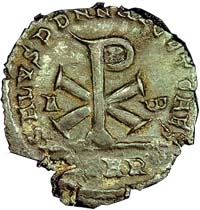 Obverse of a bronze coin issued in 353 AD by Magnentius with the Chi-Rho symbol. Alpha and Omega are also shown. Larger image. |
"Now it was made in the following manner. A long spear, overlaid with gold, formed the figure of the cross by means of a transverse bar laid over it. On the top of the whole was fixed a wreath of gold and precious stones; and within this, (2) the symbol of the Saviour's name, two letters indicating the name of Christ by means of its initial characters, the letter P being intersected by X in its centre...." (Eusebius, Life of Constantine, 1.31)
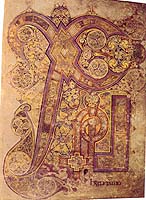 Chi-Rho in Book of Kells. Larger image. |
The Chi-Rho also appears in a different form as a monogram (folio 344r) in the famous illuminated manuscript, the Book of Kells produced by Celtic monks about 800 AD. Also in the Book of Deer, the Book of Durrow, the Corpus Irish Gospel,
- AE 2 of Magnentius. In 353 AD, near the end of his losing battle with Constantius II, the usurper Magnentius issued bronze coins showing the Chi-Rho between the letters Alpha and Omega (REV. 22:13).
- Sarcophogas with chi-rho flanked by two peacocks.
- Christian sarcophogas with two lambs flanking a chi-rho surrounded by a wreath.
- Sarcophagus with the Monogram of Christ Pio Christiano Museum, Vatican, Rome.
- Vatican sarcophagus with Chi Rho, #171, mid 4th century, Rome
- Chi Rho marking a tomb in the Roman catacombs
-
Chi-rho, Fish, and Anchor symbols, Catacombs of St. Sebastian.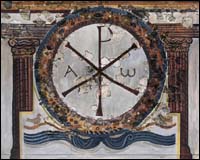
Wall painting in 4th century Roman villa, Lullingstone, Kent. (British Museum) More. -
Dove and Chi-rho inscribed in stone, Inscription of Bincentia, flanked by chi-rho, basket (signifying good works), and dove with olive branch; Catacomb of S. Sebastiano, Rome
-
Chi rho symbol accompinied by the letter alpha and omega inscribed in its upper half, adorns the roof of a Baldacchino tomb at Abbatija tad-Dejr in Rabat, Malta.
-
The Chi-Rho symbol appears as a wall painting in a 4th Century Roman villa, Lullingstone, Kent, England. The circle diameter is 90 cm. Now in the British Museum.
-
The Chi-Rho with vines and grape clusters appears on the Sarcophagus of Drausin, 6th Century, Marble, Soissons, died 680 AD (Louvre Museum, Paris).
- Labarum, Wikipedia article.
- Christogram, Wikipedia article.
 This copy of a catacomb inscription shows four symbols -- the Chi-Rho, Alpha and Omega, anchor, and leaf (unknown catacomb location). Notice that the Chi character is vertical, strongly suggesting the cross. |
Copyright © 2025, Ralph F. Wilson. <pastor![]() joyfulheart.com> All rights reserved. A single copy of this article is free. Do not put this on a website. See legal, copyright, and reprint information.
joyfulheart.com> All rights reserved. A single copy of this article is free. Do not put this on a website. See legal, copyright, and reprint information.
 |

|
In-depth Bible study books
You can purchase one of Dr. Wilson's complete Bible studies in PDF, Kindle, or paperback format -- currently 48 books in the JesusWalk Bible Study Series.
Old Testament
- Abraham, Faith of
- Jacob, Life of
- Moses the Reluctant Leader
- Joshua
- Gideon
- David, Life of
- Elijah
- Psalms
- Solomon
- Songs of Ascent (Psalms 120-134)
- Isaiah
- 28 Advent Scriptures (Messianic)
- Daniel
- Rebuild & Renew: Post-Exilic Books
Gospels
- Christmas Incarnation (Mt, Lk)
- Sermon on the Mount (Mt 5-7)
- Luke's Gospel
- John's Gospel
- Seven Last Words of Christ
- Parables
- Jesus and the Kingdom of God
- Resurrection and Easter Faith
- Apostle Peter
Acts
Pauline Epistles
- Romans 5-8 (Christ-Powered Life)
- 1 Corinthians
- 2 Corinthians
- Galatians
- Ephesians
- Philippians
- Colossians, Philemon
- 1 & 2 Thessalonians
- 1 &2 Timothy, Titus
General Epistles
Revelation
Topical

 To be notified about future articles, stories, and Bible studies, why don't you subscribe to our free newsletter, The Joyful Heart, by placing your e-mail address in the box below. We respect your
To be notified about future articles, stories, and Bible studies, why don't you subscribe to our free newsletter, The Joyful Heart, by placing your e-mail address in the box below. We respect your